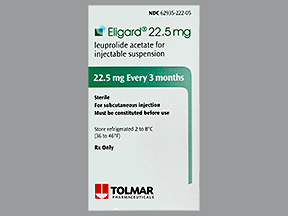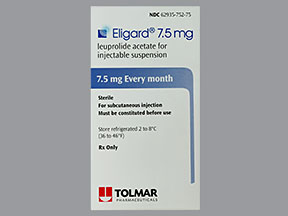|
部中文醋酸亮丙瑞林处方资料(仅供参考)
【药物名称】醋酸亮丙瑞林
【药物别名】LEUPROLIDE ACETATE、ELIGARD
【英文名称】Leuprorelin acetate
【说 明】注射液
功用作用
子宫内膜异位症;伴有月经过多、下腹痛、腰痛及贫血等的子宫肌瘤;绝经前乳腺癌,且雌激素受体阳性患者;前列腺癌;中枢性性早熟症。
用法用量
皮下注射,成人3.75mg/次,1次/4周。
子宫内膜异位症:通常,成人每4周1次,皮下注射醋酸亮丙瑞林3.75mg。当患者体重低于50kg时,可以使用1.88mg的制剂。初次给药应从月经周期的1~5日开始。
子宫肌瘤:通常,成人每4周1次,皮下注射醋酸亮丙瑞林1.88mg。但对于体重过重或子宫明显肿大的患者,应注射3.75mg。初次给药应从月经周期的1~5日开始。
前列腺癌、闭经前乳腺癌:通常,成人每4周1次,皮下注射醋酸亮丙瑞林3.75mg。
中枢性性早熟症:通常,每4周1次,皮下注射醋酸亮丙瑞林30mg/kg,根据患者症状可增量至90mg/kg。
注意事项
不良反应:内分泌系统:发热,颜面潮红,发汗,性欲减退,阳痿,男子女性化乳房,睾丸萎缩,会阴不适等现象。
肌肉骨骼系统:可见骨疼痛,肩腰四肢疼痛。
泌尿系统:可见排尿障碍,血尿等。
循环系统:可见心电图异常,心胸比例增大等。
消化系统:恶心,呕吐食欲不振等。过敏反应:可见皮疹搔痒等。
注射局部疼痛,硬结,发红。
其他
可见浮肿,胸部压迫感,发冷,疲倦,体重增加,知觉异常,听力衰退,耳鸣,头部多毛,尿酸,BUN,LDH,GOT,GPT上升等。由于雌激素降低作用而出现的更年期综合征样的精神抑郁状态.
对本药成份、合成的LH-RH或LH-RH衍生物有过敏史者禁用。孕妇或有可能怀孕的妇女,或哺乳期妇女;有性质不明的、异常的阴道出血者[有可能为恶性疾病]禁用。皮下注射部位选上臂部、腹部、臀部,注射后不得揉搓注射部位。
首次用药初期,由于高活性LH-RH衍生物对垂体-性腺系统的刺激作用,使血清睾丸素浓度上升,可见骨性疼痛暂时加重,尿储留或脊髓压迫症状,应对症处理。已存在由脊髓压迫或尿储留引起的肾功能障碍者或者是有重新发作可能性的患者及高龄者慎用。治疗时一定要确认患者未妊娠,且于月经周期的1-5天开始给药,在治疗期内应采用非激素性方法避孕。给药时应留心与类似疾患(恶性肿瘤等)鉴别,如给药过程中肿瘤增大,临床症状末见改善时应中止给药。由于雌激素降低可引起骨质的损失,故需长期给药或再次给药时,应尽可能检查骨密度,慎重用药。
对含有明胶的药物或含有明胶的食物有过敏史者,例如休克、过敏性症状(荨麻疹、呼吸困难、口唇浮肿、喉头水肿等)应慎重用药;已有因使用本品引起血栓形成及肺栓塞症的报告。
完整说明书附件:https://dailymed.nlm.nih.gov/dailymed/drugInfo.cfm?setid=b78d1919-9dee-44fa-90f9-e0a26d32481d
------------------------------------------------------------
注:以下产品美国上市,不同规格和不同价格,采购者以咨询为准。
-------------------------------------------------------------
ELIGARD 22.5MG/0.375ML PFS KIT 1/EA LEUPROLIDE ACETATE 00024-0222-05
ELIGARD 22.5MG/0.375ML PFS KIT 1/EA LEUPROLIDE ACETATE 62935-0222-05
ELIGARD 30MG/1.5ML PFS KIT 1/EA LEUPROLIDE ACETATE 00024-0610-30
ELIGARD 30MG/1.5ML PFS KIT 1/EA LEUPROLIDE ACETATE 62935-0302-30
ELIGARD 45MG/0.375ML PFS KIT 1/EA LEUPROLIDE ACETATE 00024-0605-45
ELIGARD 45MG/0.375ML PFS KIT 1/EA LEUPROLIDE ACETATE 62935-0452-45
ELIGARD 7.5MG/0.25ML PFS KIT 1/EA LEUPROLIDE ACETATE 00024-0793-75
ELIGARD 7.5MG/0.25ML PFS KIT 1/EA LEUPROLIDE ACETATE 62935-0752-75
ELIGARD KIT 22.5MG 3-MONTH 1 LEUPROLIDE ACETATE ICS TOLMAR PHARMA INC 62935-0222-05
ELIGARD KIT 30MG 4-MONTH 1 LEUPROLIDE ACETATE ICS TOLMAR PHARMA INC 62935-0302-30
ELIGARD KIT 45MG 6-MONTH 1 LEUPROLIDE ACETATE ICS TOLMAR PHARMA INC 62935-0452-45
ELIGARD KIT 7.5MG 1-MONTH 1 LEUPROLIDE ACETATE ICS TOLMAR PHARMA INC 62935-0752-75
ELIGARD 7.5MG/0.25ML PFS KIT 1/EA LEUPROLIDE ACETATE TOLMAR 62935-0753-75
ELIGARD 22.5MG/0.375ML PFS KIT 1/EA LEUPROLIDE ACETATE TOLMAR 62935-0223-05
ELIGARD KIT 7.5MG 1-MONTH 1 LEUPROLIDE ACETATE TOLMAR PHARMACEUTICALS IN 62935-0753-75
ELIGARD KIT 22.5MG 3-MONTH 1 LEUPROLIDE ACETATE TOLMAR PHARMACEUTICALS IN 62935-0223-05
ELIGARD KIT 30MG 4-MONTH 1 LEUPROLIDE ACETATE TOLMAR PHARMACEUTICALS IN 62935-0303-30
ELIGARD KIT 45MG 6-MONTH 1 LEUPROLIDE ACETATE TOLMAR PHARMACEUTICALS IN 62935-0453-45
ELIGARD 30MG/1.5ML PFS KIT 1/EA LEUPROLIDE ACETATE TOLMAR 62935-0303-30
ELIGARD 45MG/0.375ML PFS KIT 1/EA LEUPROLIDE ACETATE TOLMAR 62935-0453-45
 
ELIGARD KIT(LEUPROLIDE ACETATE)
Eligard and Night Sweats
Eligard side effects can include night sweats, nocturnal hydrosis, and hot flash like symptoms. This page helps to understand the side effects that cause increased sweating and flushing. This medication has many warnings associated with it regardless of purchasing discount online or generic. This information is always subject to change please consult you doctor before taking this medicine.
DESCRIPTION
Eligard®22.5mg is a sterile polymeric matrix formulation of leuprolide acetate for subcutaneous injection. It is designed to deliver 22.5 mg of leuprolide acetate at a controlled rate over a three-month therapeutic period.
Leuprolide acetate is a synthetic nonapeptide analog of naturally occurring gonadotropin releasing hormone (GnRH or LH-RH) that, when given continuously, inhibits pituitary gonadotropin secretion and suppresses testicular and ovarian steroidogenesis. The analog possesses greater potency than the natural hormone. The chemical name is 5-oxo-L-prolyl-L-histidyl-L-tryptophyl-L-seryl-L-tyrosyl-D-leucyl-L-leucyl-L-arginyl-N-ethyl-L-prolinamide acetate with the following structural formula:
WARNINGS Eligard® 22.5 mg, like other LH-RH agonists, causes a transient increase in serum concentrations of testosterone during the first week of treatment. Patients may experience worsening of symptoms or onset of new signs and symptoms during the first few weeks of treatment, including bone pain, neuropathy, hematuria, or bladder outlet obstruction. Isolated cases of ureteral obstruction and/or spinal cord compression, which may contribute to paralysis with or without fatal complications, have been observed in the palliative treatment of advanced prostate cancer using LH-RH agonists (see PRECAUTIONS ).
If spinal cord compression or renal impairment develops, standard treatment of these complications should be instituted.
PRECAUTIONS General:Patients with metastatic vertebral lesions and/or with urinary tract obstruction should be closely observed during the first few weeks of therapy (see WARNINGS section).
Laboratory tests: Response to Eligard ® 22.5 mg should be monitored by measuring serum concentrations of testosterone and prostate specific antigen periodically.
In the majority of patients, testosterone levels increased above Baseline during the first week, declining thereafter to Baseline levels or below by the end of the second week. Castrate levels were generally reached within two to four weeks and once achieved were maintained for the duration of treatment.
Results of testosterone determinations are dependent on assay methodology. It is advisable to be aware of the type and precision of the assay methodology to make appropriate clinical and therapeutic decisions.
ADVERSE REACTIONS The safety of Eligard ® 22.5 mg was evaluated in 117 patients with advanced prostate cancer. Eligard ® 22.5 mg, like other LH-RH analogs, caused a transient increase in serum testosterone concentrations during the first two weeks of treatment. Therefore, potential exacerbations of signs and symptoms of the disease during the first weeks of treatment are of concern in patients with vertebral metastases and/or urinary obstruction or hematuria. If these conditions are aggravated, it may lead to neurological problems such as weakness and/or paresthesia of the lower limbs or worsening of urinary symptoms (see WARNINGS and PRECAUTIONS ).
In Study AGL9909, 117 patients were dosed with Eligard ® 22.5 mg every three months for up to six months and injection sites were closely monitored. In all, 230 injections of Eligard ® 22.5 mg were administered. Transient burning/stinging was reported following 50 injections (21.7%), with the majority (86%) of these events reported as mild. Pain was reported following 3.5% of study injections (6.0% of patients) and was generally reported as brief in duration and mild in intensity.
Erythema was reported following 2 injections (0.9% of study injections, 1.7% of patients). One of the reports characterized the erythema as mild and resolved within 7 days. The other was moderate and resolved within 15 days. Neither patient experienced erythema at multiple injections. Mild bruising was reported following 4 injections (1.7% of study injections, 3.4% of patients). Mild pruritis was reported following 1 injection (0.4% of study injections, 0.9% of patients).
These localized adverse events were nonrecurrent over time. No patient discontinued therapy due to an injection site adverse event.
The following possibly or probably related systemic adverse events occurred during clinical trials of up to six months of treatment with Eligard ® 22.5 mg, and were reported in >/=2% of patients (Table 1). Often, causality is difficult to assess in patients with metastatic prostate cancer. Reactions considered not drug-related are excluded.
|
Table 1: Incidence (%) of Possibly or Probably Related Systemic Adverse Events Reported by >/= 2% of Patients (n = 117) Treated with Eligard ® 22.5 mg for up to Six Months; Study AGL9909 |
|
Body System |
Adverse Event |
Number |
Percent |
|
Vascular Disorders |
Hot flashes/
sweats * |
66 |
56.4% |
|
Body as a Whole |
Fatigue |
7 |
6.0% |
|
Genitourinary |
Urinary frequency |
3 |
2.6% |
|
Gastrointestinal |
Nausea |
4 |
3.4% |
|
Skin and Subcutaneous Tissue |
Pruritis |
3 |
2.6% |
|
Musculoskeletal |
Arthralgia |
4 |
3.4% | In addition, the following possibly or probably related systemic adverse events were reported by < 2% of the patients using Eligard ® 22.5 mg in the clinical study.
Gastrointestinal: Dyspepsia
General: Rigors, weakness, lethargy
Renal: Difficulties with urination, pain on urination, scanty urination, bladder spasm, blood in urine and urinary retention
Reproductive: Breast tenderness, testicular atrophy , testicular pain, gynecomastia , impotence
Skin: Clamminess, night sweats, sweating increased* Vascular: Hypertension, hypotension
Expected pharmacological consequence of testosterone suppression. In the patient population studied, a total of 84 hot flash/
sweats events were reported in 66 patients. Of these, 73 events (87%) were described as mild; 11 (13%) as moderate; none were severe.
Changes in Bone Density:Decreased bone density has been reported in the medical literature in men who have had orchiectomy or who have been treated with an LH-RH agonist analog. 3 It can be anticipated that long periods of medical castration in men will have effects on bone density. |



